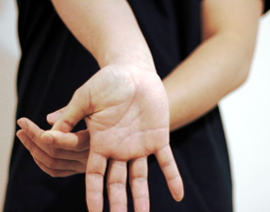- 905.829.0724
- info@yourhealthwellnesscentre.com

Tendonitis is inflammation of a tendon. It is an overuse injury, caused by chronic overload of a tendon. Factors such as muscle imbalance, decreased flexibility, poor biomechanics, improper training techniques or training errors, and chronic degenerative changes can all contribute to tendonitis.
At the beginning, you might feel pain only after you are physically active. As it progresses, you might have pain at the start and and the end of your physical activity. It can then progress to pain throughout physical activities. If it progresses far enough, the pain can become constant with even the smallest of your daily activities.
The tendons that are most commonly affected are:
In the early stages, you can control the inflammation with ice, rest, and non-steroidal anti-inflammatory drugs, following by stretching, strengthening, and a slow return to activity.
In the acute stage, your massage therapist can help with the swelling, pain, and tension in the tendon. Your therapist might use trigger point therapy on the surrounding muscles to decrease the pain. To decrease the tension, your therapist will treat some of the surrounding muscles. For example, your therapist might use the Golgi tendon organ release technique on the unaffected tendon. Compensatory muscles are also treated for tension and trigger points.
In the chronic stage, the treatment can be more aggressive. Fascial techniques are used to decrease fascial restrictions. Trigger point therapy and techniques that decrease tension are used on the affected and opposing muscles. To decrease adhesion in a tendon, your therapist might use the frictions technique or the M2T blade on the affected tendon. After a massage treatment, your therapist might recommend ice to help with the inflammation.
The recommended treatment frequency is three times a week for two to three weeks, then twice a week for one week, and then continuing once a week until the tendonitis is cleared. The length of treatment depends on the severity and length of time that the tendonitis has been present. If you start treatment when you first notice symptoms, it can take four weeks to resolve. However, if tendinitis has been left without treatment for long time it can take up to six months.
Tendonitis starts with microscoping tearing of the tendon due to overloading, which results in inflammation. If not treated, tendonitis can lead to tendinosis, which is caused by chronic overuse tendon injuries and can lead to degenerative changes in the tendon. An example of tendinosis is “golfers elbow.”
With tendinosis, there is no sign of inflammation in the tendon, but there are changes in the collagen of the tendon. As tendinosis progresses, it can cause partial or complete tendon rupture. In the chronic stage, there is chronic inflammation, adhesions, and fibrosis. The tendon can also thicken and there is decreased range of motion and decreased strength.